
Automotive engines aren’t just undergoing a radical shift from electric vehicles, biofuels represent another challenge entirely and require different types of fuel monitoring.
Biofuels and e-fuels are becoming viable options in the pursuit of decarbonisation. Alternative fuels emit less carbon throughout their lifecycle than fossil fuels. Crucially, it is possible to integrate biofuels into existing combustion engines in road, aviation, and maritime transport, provide immediate decarbonisation, and blend them with conventional fuels.
Therefore, cleaner fuel types offer a vital means to decarbonise transportation in the short term while longer-term solutions are developed.
However, alternative fuels have rigorous testing requirements that must be carefully followed to identify the presence of any contaminants and ensure operational efficiency for engines.
How hydrocarbon compatibility can create cleaner fuels
Biofuels that are most prevalent within the current market include bioethanol, biodiesel, renewable diesel, biomethanol, and sustainable aviation fuels (SAFs). These fuels are largely generated through the processing of biomass such as starch of grains, vegetable oils, animal fats, waste oils, and greases.
Despite the many advantages, most alternative fuels are not cost-competitive with conventional fuels. Biofuels have a lower energy density than fossil fuels. Therefore, engine adjustments are required when blending large volumes of biofuels.
It is also critical to ensure that resources are free of contaminants. An unclean fuel stock can damage the internal components of engines, supply systems, and other equipment. Additionally, sulphur regulatory limits must be met by all biofuels, whether blended or not. The presence of chlorine in some biofuels may also cause corrosion damage during and after the production stages. And when blending fuels, the different molecules can behave differently, which requires precise management to ensure that the fuel functions as intended.
“The first and second generation ethanol or biodiesel technologies blend into the fuel but are not the same molecules. They don’t behave the same, and there are limits to how much you can blend in,” comments Professor David Bressler, professor from the Agricultural, Life & Environmental Sciences department at the University of Alberta in Canada, in a PerkinElmer Q&A.

“Even with ethanol if you get too high a blend, you start having different requirements on the engine to handle that change. Biodiesel, again, there’s a limit to how much you can blend into the diesel resource without having problems with solubility and cloud points and so on,” he adds. “The fuels we’re looking at are more compatible. They’re hydrocarbons coming from the petroleum world. When hydrocarbons blend in, they improve product quality in terms of particulate emissions.”
Several projects are already underway to produce fuels more compatible with hydrocarbons. Prof Bressler explains that with time and advanced technologies, it is possible to create cleaner fuels from non-food-grade sources at scale using lipid-to-hydrocarbon technology (LTH).
“The LTH technology we’ve licensed to forge hydrocarbons is being benchmarked by third parties – we haven’t built it fully commercial yet – but we’re in the ballpark of a 15% to 20% carbon footprint as compared to a petroleum base,” he says.
Enabling efficient biofuels
A GlobalData report charting the growth of renewable refineries estimates that SAFs will overtake biodiesel by 2037 and grow at a CAGR of 32% between 2022 and 2040. Decarbonisation policies, such as the Refuel EU Aviation Initiative, will also facilitate this strong growth.
In such a landscape, it is essential for labs to confidently test and monitor chemical compounds crucial for biofuel research and production to meet industry performance standards. For manufacturers, storing biofuels presents a unique set of operational problems such as blocked filters, slow-running pumps, and damage to pipework and tanks, eventually resulting in possible equipment failure.
“Biofuels have different kinds of fat composition,” explains Daan Vijfhuizen, account manager at PerkinElmer’s operations in the Netherlands. “But also, the additives that are added and the effects this can have on motors of vehicles – that’s something major. Sometimes, you could have an engine failure because the engine is not ready for the different kinds of burning levels.”
To address this issue, flashpoint testing is required. Furthermore, PerkinElmer is seeking to reduce the environmental impact of its in-service testing in lab processes – with a focus on not only throughput but also sample sizing.
“There are some features in some instrumentation like the ICP-OES where we reduce the use of argon, which is a gas that’s driving the plasma,” adds Vijfhuizen.

Laboratory testing for biofuels
Collaborating with a specialist provider of analytical technology and industrial lab solutions such as PerkinElmer can help overcome many challenges with biofuels, aid predictive maintenance, and validate compliance testing of finished fuels.
For instance, compositional quality checks on blended fuel products must quantify ethanol at about 92.1% of the volume, and methanol at roughly 0.1% to 0.5%, according to ASTM standard (D4806). With its capacity to measure hydrocarbon compounds at low and high levels, PerkinElmer’s gas chromatography systems with wide-range flame ionisation detector (FID) can ease this process.
The importance of a robust GC system for biofuel analysis is a point that QA/QC labs and research institutes both agree on. Prof Bressler stresses, “I’ll be very blunt – without gas chromatography, we don’t do anything. From the very beginning right up to last week, everything we do is monitored through gas chromatography. Whether it’s online or sample taking, whether it’s the gas or liquid phase, GC is important to characterising and monitoring what’s happening within the reactor,” he states. “We’re looking at the composition, quantitating how much of everything is there.
“We’re coupling that with a mass spectrometer, looking at what’s being formed. If it’s a new compound, and we’re not familiar with it, we need both the analytical information we get from flame ionisation detectors, as well as structural information from mass spec.”
PerkinElmer offers a variety of GC configurations and detectors to meet biofuel analysis requirements. Integral liquid autosamplers or automatic headspace sampling provide scalable solutions for laboratories, big or small with field-proven instrument control and data-handling software.
On the other hand, biodiesel’s high oxygen concentration can end up absorbing XRF signals and reports lower sulphur and chlorine concentrations. Therefore, a quick and accurate test is required for authentic sulphur and chlorine levels in the biodiesel mixture. For this purpose, PerkinElmer’s ICP-OES instrument range is proven to be highly effective in detecting contaminant levels in industrial biofuels.
While a system such as PerkinElmer Spectrum Two™ FTIR Spectrometer with an ATR accessory can serve as a reliable and portable tool for determining biodiesel content according to ASTM D7371 standards. This instrument includes starter calibrations to allow for rapid deployment in the field.
“Sustainability is not only changing the kind of things you put in a car but also changing the footprint of your lab. These kinds of solutions are real game changers,” adds Vijfhuizen.
For more information on how PerkinElmer can help advance your biofuels analysis as well as other chemicals and materials used in automotives, download the Guide below.


